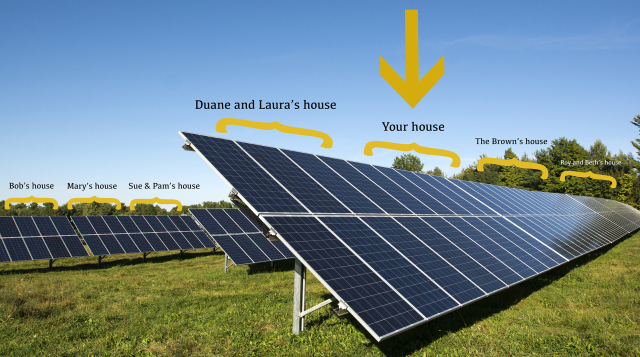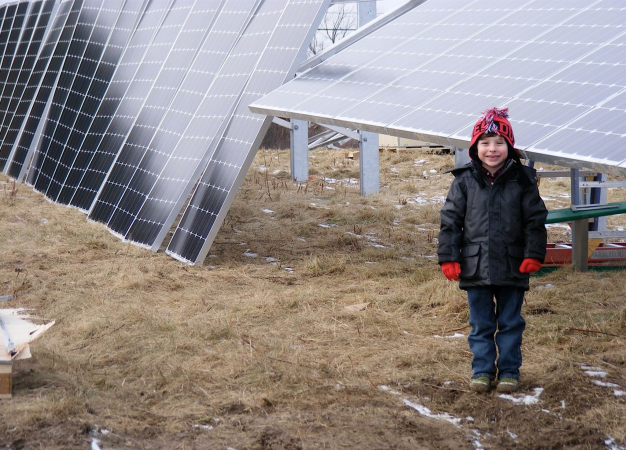Vermont B/A Magazine: Now Every Vermont Home Can Have Solar
Now Every Vermont Home Can Have Solar (Even Without A Good Site or Lots of Cash)
by Dick Nelson
Until recently there have been a number of barriers to Vermont homeowners who wanted solar electricity, both real and perceived. In the past few years, however, those barriers have fallen away, one by one. Now, there are really none left.
Prices have come down, installations have become easier, products have improved, guarantees are better. And the the largest perceived barriers, lack of sunlight and/or lack of money, have now been overcome as well.
One big answer to the last two impediments: Community Solar Arrays (CSAs).
For details, Vermont B/A spent some time with James Moore, co-founder of SunCommon in Waterbury, Vermont’s largest installer of individual solar arrays and now a leader in the burgeoning Community Solar movement, a new arrangement where a number of households can share in the benefits of a single large, shared array, which can be located anywhere in the service area of their local utility company, eliminating the problem of too many trees or not enough roof space, or both.
The other key to solar access for average Vermont families is financing.
With both their individual installations and community systems, there is no longer the enormous upfront investment, around $25,000 to $30,000. Now, homeowners simply trade in their electric bill each month for a payment to the solar company (in the case of community solar) or their financial institution (for individual installations). And it is almost always less than their electric bill had been.
“We’ve made it flexible and easy for all Vermonters,” says SunCommon co-founder James Moore, 37, who previously was program director for the Vermont Public Interest Research Group’s clean energy program. “You don’t have to have $25,000 or $30,000 in your bank account. It’s not just for wealthy Vermonters to participate.”
1,200 Installations Already
Since it was founded in 2012 by Moore and Duane Peterson, 58, formerly “Chief of Stuff” at Ben & Jerry’s, SunCommon already has more than 1,200 solar installations under its belt, making it by far Vermont’s largest solar company in that short span of time, with over half the state’s yearly installations in 2014 and revenues of about $18 million per year. Moore and Peterson met via VPIRG, where Peterson was longtime president of the board of directors. They serve as co-presidents, with each owning about one third of the company. The other third is owned by investors, including Ben Cohen and Jerry Greenfield, the Vermont Community Loan Foundation and FreshTracks Capital in Shelburne. The company is headquartered in The Energy Mill, owned by the Gristmill Builders, on Stowe-Waterbury Road, which owner Brendan O’Reilly believes to be the only net zero commercial building in Vermont (complete with a free-standing solar array).
“When we started this gambit together,” says Moore,” we did a division of labor where Duane focuses on the marketing end of things, our investor relations and all things kind of internal, administrative legal and whatnot, and I focus on the solar sales, customer service, design, engineering and government relations. We both think we have the better half, so it’s perfect.”
Until last fall, most of the installations were for individual homeowners, working with banks and credit unions, to work out loans, typically on a 20-year term. At the end of the 20 years, the homeowner owns the system, and the electricity it generates going forward is free. The solar panels that SunCommon uses, from SunPower in San Jose, CA, have a 25-year-warranty.
This approach virtually eliminated the “I don’t have a big wad of cash” impediment. But it still left the “I don’t have a good site, enough rooftop” dilemma. Enter Community Solar.
Community Solar Takes Hold
“The Community Solar program just started in fall 2014,” says Moore. “We needed to get it affordable and get the legal structure worked out.”
They have done that and things are going great guns. “Vermonters pay a monthly fee,” Moore explains, “and get a monetary solar credit on their electric bill each month. It’s called group net metering. It’s pay-as-you-go and safe. What they pay SunCommon is going to be less than what they’d pay directly to their utility. If the community array overproduces, CSA members get the extra credit at no additional cost. Homeowners are participants. If they move somewhere else in Vermont (within the same utility service area), they can just head out and sign up in their new home. No strings attached.” There is no upfront cost to join a CSA and membership payments are fixed for the 20-year membership period. So as utility rates increase CSA payments remain the same. SunCommon is responsible for maintenance of the common array, such as mowing the grass and maintaining the equipment.
Moore said the average Community Solar Array takes up about an acre of space and serves about 30 families, with a cost of about $500,000 per project. “We pay a good rate to the hosts, “ he says, adding that builders and developers are prime partners in future CSA installations.
“They know where the land is, where a sunny acre of land is. It would be a real service to those homes they build, to the community, and a good way to make money if they are the host. We pay them for the use of the land.”
If a homeowner moves out of the service area and cannot continue as part of the CSA, they pay a flat fee, equal to three months of payments, to SunCommon to allow the company to locate and bring in a new member household. Other than that, no obligation.
A key ingredient in the arrangement is the 30 per cent federal tax credit for solar installations through 2016. That goes to SunCommon as the owner of the community array.
All SunCommon installations, on individual homes and for the CSAs, are done by Peck Electric.
Interest Growing
Moore says several employees on the 62-person SunCommon staff are devoted to creating interest in solar, and CSAs.
“We do a lot of community outreach,” he says. “We talk to the planning board, make sure it fits in the landscape. We want this to be something that’s embraced as part of our rural Vermont landscape. We’re doing this to serve the communities we live and work in and help Vermonters save money as we transition away from dirty and dangerous energy sources.”
One of the outreach workers is 22-year-old Carson Casey, who serves as solar organizer for Chittenden County.
“I’m the face of SunCommon in the community,” she says. “My job is to do education and outreach, grassroots marketing.” She goes to farmers markets and town festivals, and organizes parties in existing customers’ homes, to drum up interest.
Other solar companies are also offering community arrays. Saxton’s River Solar Electric Company went online with Phase One of their CSA in October 2013 and are now organizing Phases Two and Three.
Catamount Solar will be installing a CSA on the roof of the North Thetford Community Church to provide electricity for the church and four participating households. And these are only the beginnings.
Whether as part of a community array or an individual installation, solar is booming, even though a state incentive wound down and expired at the end of 2014.
A 2011 survey from the National Renewable Energy lab found that houses with solar panels sold 20 percent more quickly than others, with asking prices 17 per cent higher.
Moore says that Green Mountain Power is on board because they realize that this is what a vast majority of their customers want.
Chris Recchia, commissioner of the Vermont Dept. of Public Service, noted that SunCommon’s staff is part of a solar workforce that amounts to about 17,000 jobs to date.
“This is the stuff the public wants,” Recchia reiterated,” and solar is consistent with our energy plans of getting more distributed generation, making us more energy independent and secure” as Vermont strives toward its goal of 90 per cent of its energy from renewable sources by the year 2050.
Peterson states: “We believe everyone has the right to a healthy environment and safer world, and clean energy is the place to start that. We want to knock down the barriers that have made renewable energy inaccessible. We strive to make this easy and affordable, so everyday Vermonters can get in on this. That’s our mission.”
The last word comes from SunCommon’s very first customer, Chris Pierce of Montpelier, who states: “The only question that remains is, ‘Why not?”




